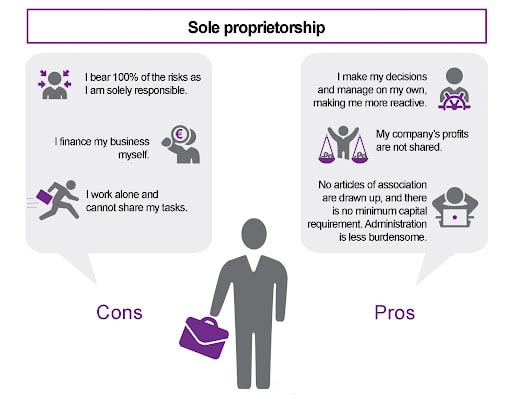Table of Contents
Starting a business can be exciting, but it’s also challenging. It’s one of the biggest decisions you’ll make in your life, so you want to choose the right path for your business. So let’s enlighten the topic of How To Run A Startup As A Sole Proprietor or Freelancer?

There are many different ways to start a business — from starting an online store to becoming self-employed as a freelancer — and each has its pros and cons.
Here are some of the pros and cons of starting up as a sole proprietor or freelancer:
Pros of Sole Proprietor:
- You get complete control over what happens in your business.
- You don’t have to worry about hiring employees or managing their benefits (like health insurance).
- It doesn’t matter if you’re operating on a small scale or a large scale, as long as you’re growing steadily.

Cons of Sole Proprietor:
- You have less security than if you were working with other people in the company (but this can be good or bad depending on how much risk you want).
- You’ll be responsible for everything that goes into running your business — including paperwork and other administrative tasks. This can be time-consuming which can take critical time away from building your business.
- If the business takes off, it will become more difficult to grow due to limited resources (money) and time.
- There are government regulations on how you can hire and fire employees, PF contributions, etc.
- You can experience a hard time finding the right business idea. There are a lot of ideas out there, and it can be difficult to find the right one.
- Finding the right location for your business. You need a space that you can use to run your business. If you are going to hire employees, then you’ll need more space than if you’re going to do it all yourself.
- Making sure that you’re ready for any potential difficulties that could come up during your startup. You might want to get some help from others so that they can help keep things running smoothly while you focus on other aspects of running your business.
How To Overcome The Paperwork Challenge?
Getting started with a business can be daunting. You will have to deal with all the paperwork, even if you are just starting out and don’t need a lot of capital funding.
The good news is that there are ways around this and many startups don’t need to file any paperwork at all.
For example, one way to circumvent the challenges of paperwork is by doing business as a sole proprietor or a freelancer and hiring workers on a freelance basis. You do not need to pay any taxes, and you can start your business with little to no capital.
However, there are some risks involved in this type of setup, such as:
- You cannot get institutional funding like bank loans or VC funding since that requires a registered entity like an LLC.
- Also, since you are legally the same as the business, you carry personal liability towards any dues. For example, if someone sues the business, then you will be liable to pay for the damages from your personal account.
- This also means that your employee will not be entitled to social security benefits since he has been hired as an independent contractor rather than an employee.
So, only try this if you do not need a lot of capital funding, and also the business does not have potential liabilities (including workplace hazards).
How To Run A Startup As A Sole Proprietor Or Freelancer?
Step 1: Create SOPs For All Your Work Processes
If you’re a sole proprietor or freelancer, you’ll have to create your work processes and procedures. These can be as simple as a checklist that you use to run your daily business — but they can also be much more complex.
The best way to do this is by creating SOPs (standard operating procedures). These are detailed instructions that outline how things will be done in your business, and they should take the form of written guidelines that employees follow every day.

For example, if you’re running a small eCommerce store, you would create an SOP for each area of your business: product procurement (where items come from), marketing (how you promote products), CMS management (what software you use), customer support (how customers get help), etc.
Also, using eCommerce marketing automation software, you can replace repetitive marketing tasks like follow-up emails/texts and fully automate a good chunk of SOPs If you are hiring people who are somewhere on the spectrum between freelancer and employee in terms of their skill set and experience level, then it’s time to start thinking about how you will manage them. You need to have a process that is standardized across your entire business so that everyone works off the same playbook while running a startup as a sole proprietor.
Step 2: Establish Time Frames For Each SOPs
Each process should have time frames assigned to it so that the person responsible for completing these tasks knows when they have to be done.
For example, The product procurement SOP has four stages; stage 1 is getting in touch with suppliers/manufacturers; stage 2 is doing initial due diligence on suppliers/manufacturers; stage 3 is negotiating terms and conditions, and stage 4 is signing contracts. Each phase would have its timeline assigned to it so that there is no unnecessary delay in taking action on any part of the project.
Step 3: Define The Roles And Responsibilities Of Each Team Member
Define the roles and responsibilities of each team member. This will help you know what is expected of each team member and how they are expected to work together.
For example, it may be necessary to have a certain person be in charge of certain tasks or projects. If you don’t know yet who should take care of which task or project then this step will help you determine who should take care of what task or project.
Step 4: Set Goals For Each Team Member And Measure Their Performance Against Them
Once you have defined the roles and responsibilities of each team member, it’s time to set goals for each team member and measure their performance against those goals. This will help ensure that everyone stays on track with their work and does not fall behind on deadlines. It also allows for better communication between members so that everyone stays informed about what’s going on with their respective tasks/projects.
Step 5: Find And Hire Great People
If you are hiring people who are somewhere on the spectrum between freelancer and employee in terms of their skill set and experience level, then it’s time to start thinking about how you will manage them. You need to have a process that is standardized across your entire business so that everyone works off the same playbook while running a startup as a sole proprietor.
Work out the exact skill sets necessary. Oftentimes, it is cheaper to hire someone to do a particular task rather than making it subjective and letting them figure it out.
Use third-party platforms like UpWork or Fiverr to hire skilled freelancers within a tight budget. You can also post jobs on LinkedIn and highly-niched Facebook groups. Another thing you can do is to outsource your recruitment process to professional employers organizations that can help with selecting the right candidates for your needs.
Step 6: Create A System To Track Time And Expenses
You will need to track every single minute of your time. Process automation is the way to hyper-increase your team’s productivity and best juice out the time spent behind the desk. You should also be able to calculate your expenses. You must measure how much money is coming in and going out of your business.
Step 7: Pay On A Project Basis (mostly)
While running a startup as a sole proprietor or freelancer is great for control and flexibility, it’s also extremely challenging to manage cash flow. You need to take on new clients and projects, but you don’t want to burn through all your savings too quickly.
One way is by paying on a project basis instead of hourly. This allows you to keep the outgoing payments predictable and prevent overspending. It also helps you focus on getting the most value out of each client (and freelancer) and project.

Another way is by using tools that allow you to collaborate with your team members even if they’re not physically in the same place at the same time. Async communication tools like Slack or Basecamp can help make sure everyone knows what’s going on and what needs to be done next without having to wait for responses from far-away team members who may be unavailable due to working late hours or business travel schedules.
Step 8: Hire Your Freelancers As Full-Time Employees When The Business Gains Traction
Once the business gains traction, consider hiring your freelancers as full-time employees. While this increases overheads on your part, you are also bringing in an experienced bunch of people who can help you establish continuity in business.
For example, if you have a web designer who is working on your website at the moment, he may not always be available to handle projects for other clients. So if you want him to continue working for you and earn more money, consider hiring him as a full-time employee so that he will be available to work on new projects and earn more money.
There are many benefits to running a startup as a sole proprietor or freelancer. Chief among them are flexibility and the ability to go with the flow. There’s also no need to worry about sharing equity with partners or investors — and if you get tired of working on your business, you can stop whenever you want. Stay enthusiastic!

